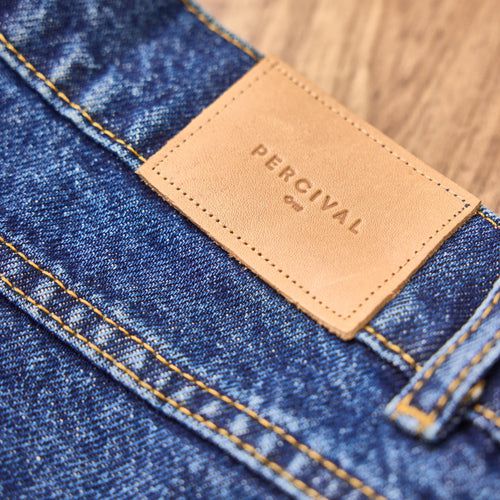
What is denim?
Denim is the fabric of the people. Tough, durable, stylish, everyday wear for fashion icons, builders, football managers, builders, cowboys, and everyone in between. It’s good for jeans, shirts, trousers, overshirts, jackets—just maybe not underwear.
Is denim cotton?
Sure is. Denim is essentially a cotton twill—tough and durable—but it’s made in a specific way that produces the men’s jeans, jackets, and shirts we take for granted every day. Mozart and The Sex Pistols all had the same musical notes to play with—it’s all about how you thread them together, as we’re about to discover.
How is denim produced?
Take a horizontal weft of cotton thread, pass that under at least two vertical warp threads, and keep on doing that until a pair of men’s jeans appears in front of your eyes. It’s this particular way of weaving cotton thread that gives denim that diagonal kind of gradient you’d never noticed until we just brought it to your attention and you had a quick look to make sure we weren’t talking nonsense.

How to wash denim clothing
Honestly, if it’s not visibly dirty or stanky, a couple washes a year will see you right with denim clothing. For real, though. This isn’t like when your crystal-collecting, tarot enthusiast pal tells you not to wash your hair for a decade—no, this is legit advice. Denim clothing doesn’t need washing regularly unless you’ve fully soiled it.
Otherwise, just pick a couple of days a year—perhaps the summer and winter solstices or the spring and autumn equinoxes—turn your denim inside-out, stick it in a lukewarm wash in some gentle detergent, and you’re all set.
What temperature to wash denim?
We’d recommend washing your denim clothing at 30 degrees or lower to avoid shrinkage. Denim is tough and durable when you’re wearing it, but it won’t deal particularly well with a hot wash. Think of it as a mogwai that you don’t want to turn into a gremlin.
Can you tumble dry denim?
We wouldn’t recommend tumble drying your denim clothing. Unless you’re actively trying to shrink it, tumble drying is likely to significantly transform your denim in undesirable ways. Instead, hang your denim up to dry by the ankles (or the cuffs) so that the water drains toward the waistband and dries more efficiently.
Shaping Denim
How do you shrink denim?
Got some genuinely useful information for you here: Some denim has been pre-shrunk. Did you know that? It’s called being ‘sanforized’, after a bloke called Sanford Lockwood Cluett who first did it back in the 1930s. If your denim hasn’t been sanforized, it’s going to shrink on its first wash. Check the label, friends.
If your denim has been pre-sanforized, soak it in some hot water and check regularly. You can always shrink your denim further, but it’s a little harder to reverse the process.
How to stretch denim clothing
The best way to stretch your denim to fit your body type is to spray it with hot water from the sort of bottle you might use to mist your houseplants, stretch manually the areas you want to stretch, and, whilst it’s still a little damp, let it dry as you wear it. It’s not ideal but it will give you the most accurate and well-fitting stretch.

History of Denim
Denim’s history is a classic example of one of life’s happy accidents that ended up sticking around and finding a place for itself in this world, like your younger sibling, and it starts in… Europe(?!).
Who invented denim material?
Denim is the most American thing in the world aside from cowboys and childhood obesity, right? Wrong. Denim was originally created in France. In Nimes, in fact. It is from Nimes… De Nimes… De Nim… Denim… Whoa!
They were trying to make corduroy because the French weavers had seen Italians swanning about in their gorgeous corduroy trousers, but they failed and ended up with denim. The first all-cotton denim was manufactured in England before Levi Strauss mastered the art over in the States and made denim the cultural phenomenon that it is today.
Then, Percival improved upon Levi’s ideas when we released our Straight Leg Denim Jeans.